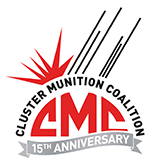Why the CMC?
On April fourth, International Day for Mine Awareness and Assistance in Mine Action, it is perhaps fitting to look back at the role that NGOs fighting against the use of landmines had in creating the CMC, sister organization to the ICBL.

Although use of cluster munitions dates back to WWII, and despite becoming widespread in Southeast Asia in the 60s and 70s, it was the increased intensity of use around the turn of the century that spurred individuals and organizations into action. NATO’s use in the former Yugoslavia in 1999 lead to a moral outcry at the number of civilian casualties caused not only by cluster munition strikes, but by explosive remnants of war (ERW) stemming from use. Acting like landmines, ERW kill and maim indiscriminately, and with the success of the 1997 Mine Ban Treaty in proving that efforts to change state policies and practices can be achieved by concerted action, NGOs from that sector began pressing governments to take up the ERW issue.
With the unrestrained use of cluster munitions by coalition forces in Afghanistan and Iraq in 2001–2003, NGOs concluded that the shocking number of civilian casualties was set to continue and was becoming viewed by states as the tolerable consequences of use. Motivated by this prospect, in 2003 they met and agreed to undertake a sustained and coordinated campaign against cluster munitions. In November of that year the CMC was launched, representing the cumulative efforts of NGOs against cluster munitions, and calling for an immediate moratorium on use, an acknowledgment of states’ responsibility for ERW, and a commitment to provide resources to affected areas. In 2008 the Convention on Cluster Munitions was signed by 96 states. Today, fifteen years after it was founded, the CMC is still fighting for change.
This is part one in a series of web stories that celebrates the double anniversary year of 2018. In the coming weeks and months further stories will be published, covering topics such as: the various campaigns used to promote the ban over the years; a focus on the broader network; five- and ten-year milestone updates; where are we now; and which states could easily join the treaty.


